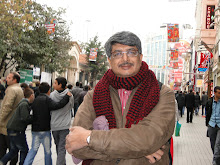We were to report at Kathmandu on 31st July but had to postpone this by a day. Our departure for Tibet was scheduled for 2nd August. In retrospect this was a bad decision as this denied us rest and hurried the process of our acclimatising causing us some additional discomfort. Mind you Kathmandu is at 1300 mtrs (4300 ft) above sea level. Our next stop was at 3750 mtrs (12400 ft) above sea level.
 We reached Kathmandu on 1st August at about 9.30 am (15 minutes ahead of IST). The airport seems a very relaxed place with almost no security there. Photography is permitted and one could click away even on the tarmac. That was a culture shock to me. Well, swine flu panic had set in and we were screened on arrival. The airport building by itself is very unremarkable and in the main arrival hall, tubelights were'nt switched on were not replaced. (surely some Indian sheds masquerading as airports must be like this)
We reached Kathmandu on 1st August at about 9.30 am (15 minutes ahead of IST). The airport seems a very relaxed place with almost no security there. Photography is permitted and one could click away even on the tarmac. That was a culture shock to me. Well, swine flu panic had set in and we were screened on arrival. The airport building by itself is very unremarkable and in the main arrival hall, tubelights were'nt switched on were not replaced. (surely some Indian sheds masquerading as airports must be like this)
We were met by a representative of Richa Tours, reputed to be one of the best organiser on the Kailash-Mansarovar circuit. After a short drive through the chaotic streets we reached our place of stay - Hotel Shanker near the Royal Palace..(The Royal Palace is now converted to a museum). Hotel Shanker is a magnificent structure and was once the abode of some long forgotten "royal".
Kailash-Mansarovar circuit. After a short drive through the chaotic streets we reached our place of stay - Hotel Shanker near the Royal Palace..(The Royal Palace is now converted to a museum). Hotel Shanker is a magnificent structure and was once the abode of some long forgotten "royal".
We did not have much to do except walk through the streets nearby. Our leisurely walk was interrupted by a heavy shower and we had to scurry back to our hotel. We had to pack all our stuff in a massive duffel bag made available by the tour organisers. No suitcases are allowed on the tour....so if you are planning to go next year...please remember this. You will have to leave behind the suitcases.
We were also given a "Down Jacket" (on a returnable basis) for the yatra. The rustic that I was till then, this term flumoxed me. I could not imagine what is "down" in this jacket. Some one equally ignorant felt it is so called because it is long and extends to one's knees. The joke was on us when we saw those jackets. This thick jacket meant I had to leave some warm clothing back at Kathmandu.
We then had to be ready for our briefing for the trip and precautions that we had to take for easy and early acclimatising.
The most scary part, atleast till then, was the high altitude problem. We were anxious to understand as to how we could overcome this problem. High Altitude problems can hit anyone at any time. Typically one would feel disoriented, tired at slightest effort or movement, breathlessness, blurred vision, headaches, loss of appetite and in some cases tummy upsets.
We were advised to
1. Rest, rest and rest. Lying down helps reduce symptoms and also recover faster,
2. Drink plenty of fluids. The sherpas ensured that we had atleast 3 - 4 litres of water every day,
3. Take Diamox tablets for the first four days....(helps in acclimatising)
4. Keep head, ears and our neck covered...prevents headaches and catching colds
(You may want to look up this article or Wikipedia on this). After this briefing, HAS did not seem so scary. It just required some common sense precaution to be taken. Our sherpas told us later that many just laugh at this and ignore this advice only to face serious problems later.
It was time to tuck in and await the next morning before we could embark on our most awaited and exciting journey.
 We reached Kathmandu on 1st August at about 9.30 am (15 minutes ahead of IST). The airport seems a very relaxed place with almost no security there. Photography is permitted and one could click away even on the tarmac. That was a culture shock to me. Well, swine flu panic had set in and we were screened on arrival. The airport building by itself is very unremarkable and in the main arrival hall, tubelights were'nt switched on were not replaced. (surely some Indian sheds masquerading as airports must be like this)
We reached Kathmandu on 1st August at about 9.30 am (15 minutes ahead of IST). The airport seems a very relaxed place with almost no security there. Photography is permitted and one could click away even on the tarmac. That was a culture shock to me. Well, swine flu panic had set in and we were screened on arrival. The airport building by itself is very unremarkable and in the main arrival hall, tubelights were'nt switched on were not replaced. (surely some Indian sheds masquerading as airports must be like this)We were met by a representative of Richa Tours, reputed to be one of the best organiser on the
 Kailash-Mansarovar circuit. After a short drive through the chaotic streets we reached our place of stay - Hotel Shanker near the Royal Palace..(The Royal Palace is now converted to a museum). Hotel Shanker is a magnificent structure and was once the abode of some long forgotten "royal".
Kailash-Mansarovar circuit. After a short drive through the chaotic streets we reached our place of stay - Hotel Shanker near the Royal Palace..(The Royal Palace is now converted to a museum). Hotel Shanker is a magnificent structure and was once the abode of some long forgotten "royal".We did not have much to do except walk through the streets nearby. Our leisurely walk was interrupted by a heavy shower and we had to scurry back to our hotel. We had to pack all our stuff in a massive duffel bag made available by the tour organisers. No suitcases are allowed on the tour....so if you are planning to go next year...please remember this. You will have to leave behind the suitcases.
We were also given a "Down Jacket" (on a returnable basis) for the yatra. The rustic that I was till then, this term flumoxed me. I could not imagine what is "down" in this jacket. Some one equally ignorant felt it is so called because it is long and extends to one's knees. The joke was on us when we saw those jackets. This thick jacket meant I had to leave some warm clothing back at Kathmandu.
We then had to be ready for our briefing for the trip and precautions that we had to take for easy and early acclimatising.
The most scary part, atleast till then, was the high altitude problem. We were anxious to understand as to how we could overcome this problem. High Altitude problems can hit anyone at any time. Typically one would feel disoriented, tired at slightest effort or movement, breathlessness, blurred vision, headaches, loss of appetite and in some cases tummy upsets.
We were advised to
1. Rest, rest and rest. Lying down helps reduce symptoms and also recover faster,
2. Drink plenty of fluids. The sherpas ensured that we had atleast 3 - 4 litres of water every day,
3. Take Diamox tablets for the first four days....(helps in acclimatising)
4. Keep head, ears and our neck covered...prevents headaches and catching colds
(You may want to look up this article or Wikipedia on this). After this briefing, HAS did not seem so scary. It just required some common sense precaution to be taken. Our sherpas told us later that many just laugh at this and ignore this advice only to face serious problems later.
It was time to tuck in and await the next morning before we could embark on our most awaited and exciting journey.





5 comments:
I'm awaiting the next installment...
Same here!
Since you did clarify for readers, Let me mention that a down jacket is filled with body down i.e. feathers, the small, soft feathers that lie below the outer feathers on a bird's body, natal down or powder down. Nothing gives better insulation.
Nice narration, Mavin. It's as though we are going on this journey with you!
Thank you
Vinod...
I missed clarifying that. These feathers are stuffed in and believe me that was very effective in shutting out the cold and gale type winds that blew in the late afternoons.
Infact, I would sweat profusely in the afternoon if I had the jacket on.
You have hit the nail on its head and I could not have defined it better. Thanks
Hi Mavin!
Great start, I am curious to read what happens next. The highest altitude I have been to is 13,500 ft. and even that was extreme. I had a 'nothing will happen to me' mindset but I was struck with mild altitude sickness and now I am the greatest advocate of acclimatizing. :)
Post a Comment